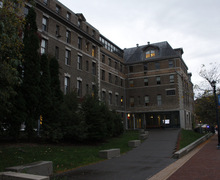Art exhibit promotes wellness, body acceptance
Will Fudge | Staff Photographer
Titled “Come As You Are,” an exhibit at the Barnes Center at The Arch aimed to raise awareness about eating disorders through drawings, photographs and short pieces of writing.
An art exhibit promoting body acceptance and wellness sat in the recreation lobby of the Barnes Center at The Arch, where students passed through on their way to exercise or get a smoothie from Otto’s Juice Box.
Dedicated to National Eating Disorders Awareness Week from Feb. 24 to March 1, the exhibit, titled “Come As You Are,” was on display through Sunday. It included about 20 pieces of student-created art, with works such as photos, drawings and poems.
Alexandra Nicole Santiago, a Syracuse University student and peer educator with Be Wise and Students Advocating for Mental Health Empowerment, came up with the idea for the art installation.
Santiago said the purpose of the exhibit is both to raise awareness of eating disorders and validate everyone’s feelings. The exhibit creates a space for people to express themselves without being told what to say, she said.
“People don’t have to feel like they don’t fit a certain model or a certain category,” Santiago said. “We invite everyone to participate.”
Santiago said she fell in love with art while abroad in Florence, Italy. She wanted to raise awareness through art, rather than other platforms such as social media, because of its therapeutic qualities, she said.
Christina Papaleo, a disability access counselor at the Office of Disability Services and a part-time student in the School of Education, said she wanted to get involved with the NEDA exhibit because of her experience as an eating disorder survivor. The art exhibit was the first time Papaleo openly shared her experience of her battle with an eating disorder and her journey to recovery, she said.

Christina Papaleo created a piece titled “Nothing is Wasted” that includes drawings of a broken bowl mended with gold and a flower growing out of a trash can. Will Fudge | Staff Photographer
Papaleo submitted a collage of drawings titled “Nothing is Wasted” for the exhibit. The collage includes drawings of a young girl crying, a broken bowl mended with gold, a girl holding a mirror and a flower growing out of a trash can.
“I’ve always used art as a place of restoration and healing for me, and I wanted to communicate that through this piece — that the bravest place that I’ve ever stood is in front of a mirror,” Papaleo said. “And when I present my beautifully broken, authentic self to the world, that’s where I find the most freedom.”
One of the pieces in the exhibit, a photograph taken by Bhoomi Thakkar, a first-year graduate student, depicts the lower half of a woman’s face and three types of cutlery: a fork, a knife and a spoon. One side of the woman’s face appears polished and made up, while the other has streaks of mascara.
Thakkar said the piece shows three perspectives about the views of individuals and society toward eating: taking care of oneself, being too harsh on oneself and society’s judgments and expectations about eating.
As a peer educator for SAMHE and a member of the NEDA week task force, Thakkar helped organize the exhibit in addition to submitting this piece.
First-year graduate student Braeden Raymer decided to submit a piece to the exhibit because he said his past works fit with the overall theme of the installation. Raymer said that much of his work explores more natural, rather than idealistic, body types.
“Some of the art that I make and a lot of the art that I take in is, I think, putting more realistic body types in art and giving people a lens to sort of see themselves in,” Raymer said.

Dedicated to National Eating Disorders Awareness week, the exhibit featured about 20 pieces of art promoting messages of wellness and body acceptance. Will Fudge | Staff Photographer
Raymer added that the NEDA week art installation differs from other exhibits he’s participated in because it is in a public place rather than an art gallery. The exhibit “stands out as being sort of out of the ordinary,” and people may not expect to see art while they’re walking around, he said.
SU senior Abby Tattle is creating a documentary about eating disorders for her capstone. After a friend told her about the NEDA week exhibit, Tattle submitted two spoken word poems that she wrote as extra material for her documentary.
One of the poems, titled “Type A” deals with what Tattle describes as the current culture’s obsession with external perfection in everyday life and how this connects to addiction and eating disorders.
Tattle said she has been dealing with an eating disorder since the beginning of her college career and is now in a place of recovery. Her other poem, titled “Beyond the Mirror,” describes an experience she had her freshman year, when she realized she was justifying her actions as being for health and wellness purposes, she said.
Tattle said it’s important to raise awareness about eating disorders to change the stereotypes and stigmas surrounding them. Despite traditional narratives that state eating disorders only affect teenage white girls, they can affect people of race, sexuality and gender, she added.
Art plays an important role in raising awareness because people can easily digest it and can often relate to it, Tattle said.
“I think art is really reflective because it is subjective, so you can take away your own personal meaning from it,” Tattle said. “I think it’s really important in any sort of change, in any sort of situation, like you need art in order for there to be some sort of call to action.”
Published on March 1, 2020 at 11:08 pm
Contact Mandy: ackrayna@syr.edu | @MandyKraynak





